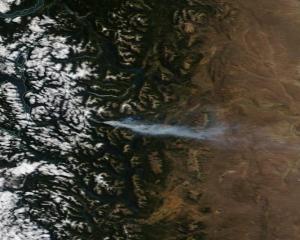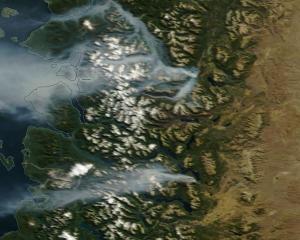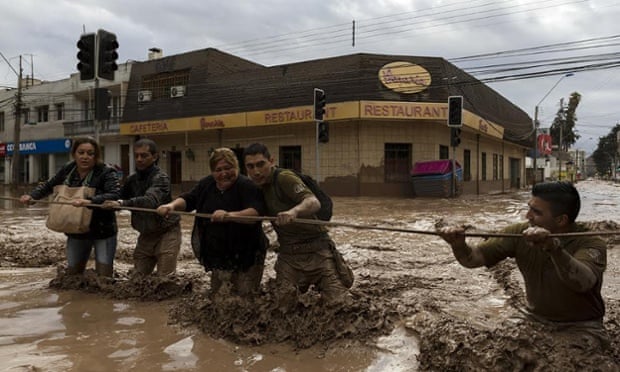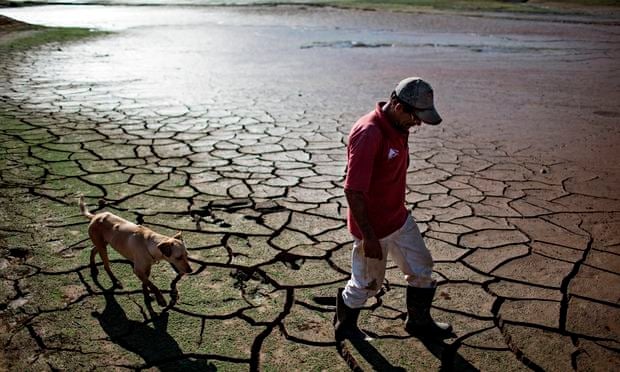This paints an amazing picture of the collapse of climate patterns in a whole continent- from the devastating drought in Brazil affecting its largest city and the Amazon basin; to huge forest fires in Patagonia; floods in Chile and feet of hail falling at the equator
Drought
in São Paulo: Brazil’s Megacity on Verge of Crisis as Water
Rationing, Shutoffs Continue
28
March, 2015
The
past three months have seen the driest winter in 84 years in
southeastern Brazil. Water shortages are now critical in São Paulo,
home to twenty million people. The city’s primary reservoir is
fluctuating between 6-13% of capacity, and officials are estimating
São Paolo’s reserves will last a mere 90 days without additional
rainfall. The rainy season, from December through February, is over,
and sadly, recent flooding within the city has not raised main
reservoir levels, which are located further inland. (1)
The
primary reservoir at Cantareira feeding much of the metropolitan
city is nearly bone-dry. People in São Paulo are resorting to
deliveries from bicycle riders carrying jugs of water. Others are
digging their private wells on their own land or even in basements,
which can lead to contamination issues. Those who can afford it are
hoarding water, and the more resourceful are using cisterns and
building rainwater catchment systems. Local rivers are polluted due
to sewage problems and cannot be used for drinking water. Some have
simply fled the city, becoming 21st century “water refugees”.
(2)
Due
to the massive glaciers of the Andes, the Amazon and its
tributaries, Brazil holds 12% of worldwide freshwater and is called
“the Saudi Arabia of water”. So why is this drought happening?
Scientists are citing deforestation of the Amazon, Brazil’s very
own “chainsaw massacre”, as the causal factor of the drought. As
climatologist Antonio Nobre explains:
“That’s what we have learned – that the forests have an innate ability to import moisture and to cool down and to favour rain… If deforestation in the Amazon continues, São Paulo will probably dry up. If we don’t act now, we’re lost.” (3)
Government
officials deserve part of the blame, as Brazilians cited recent
elections and last year’s World Cup, which conveniently allowed
politicians to procrastinate and avoid the problem. This could
eventually become a public health issue, as a surge in demand for
new wells has led to unprofessional drilling techniques. Well
experts estimate only 20% of new drilled wells meet guidelines. (4)
São
Paolo isn’t the only city in Brazil facing drought conditions. Rio
de Janeiro and Belo Horizonte are also facing water shortages,
putting a total of 40 million people at risk in the region,
comparable to the entire NYC and LA metro areas in the US. The
situation is taking a toll as GDP is predicted to fall in the area,
and experts question the government’s readiness for the 2016
Olympics in Rio. At the same time, the Petrobas bribery scandal
widens and the Rousseff government is coming under intense scrutiny,
which may distract leaders from solving the water crisis.
Due
to state incompetence and fealty towards private industry,
southeastern Brazil’s water reserves have been irrevocably
altered. The megaregion will now be forced to limit public and
industrial use if it wants to maintain civil stability. Whether the
political class has the guts to go through with a major conservation
program is questionable. Dilma Rousseff’s Workers’ Party, dubbed
as leftist by mainstream analysts, is more accurately a blend of
center-left democratic socialism and neoliberal economic practices.
The government swings between populist Bolivarian policies to
appease its vast working class, and deregulated financial and
industrial policy to please its corporate masters.
Brazil
is far from the only nation at risk from drought: last year, parts
of India, China, Ethiopia, Australia and many smaller countries were
at risk. California is estimated to have only one year of water
supplies at current usage rates. São Paulo presents a particularly
dangerous test case because it is one of the first modern megacities
facing this issue.
Despite
the siren calls of the global elite, the 21st century may not
turn out to be a model of technological advancement and social
stability. Global warming, deforestation, and resource depletion are
all intensifying, and could easily lead to a century of climate
refugees and worldwide impoverishment. World leaders working with
NGOs should be at the forefront of climate change issues, rather
than indulging in political chess games in Syria, Ukraine, Iran,
Yemen, and beyond.
Notes:
From last year
(Smoke from wildfires covering almost all of the Amazon on August 20, 2014. For reference, bottom edge of frame is 1,000 miles and the Amazon River flows from middle left until it terminates at upper right into the South Atlantic. Image source: LANCE MODIS.)
Forest
fire destroys Argentine wildlife
Severe
drought in southern Argentina has caused thousands of acres of
ancient forest to be consumed by flames
The fire has been raging through forest in Chubut since 15th February (Photo: Pablo Wegrzyn, via Télam)
Severe
drought in southern Argentina has caused thousands of acres of
ancient forest to be consumed by flames.
Report:
Forest
fires rage in Argentina's Patagonia
al
Jazeera
And Chile
High Winds, Drought Feed Chilean Forest Fires
A forest fire burns out of control in Valparaiso, Chile, March 14, 2015.
VOA,
24
March, 2015
SANTIAGO—Strong
winds and unusually hot weather in southern Chile are fueling
out-of-control forest fires, which are consuming large swaths of
national parks and ancient woodland parched by a prolonged drought.
The
fires have burned over 6,000 hectares (14,800 acres) at the China
Muerta and Nalca Lolco reserves, as well as the Conguillio national
park, revered for its forests of thousand-year-old Araucarias, or
monkey puzzle trees.
Strong
winds, drought and a strike by firefighters have hindered efforts to
fight the blazes. Worried residents have complained that authorities
have been slow to react.
"We
ask the government to urgently bring the air support needed to fight
the fire. ... We firmly believe that if stronger measures aren't
taken to stop the fire, the ecological damage will be irreversible,"
the indigenous Pewenche community of Quinquen said in a statement.
But
heavy winds, forecast to persist, have kept firefighting aircraft
grounded.
"We
expect that on Thursday weather conditions will allow the airplanes
and helicopters to fly and drop fire-retardant liquids," said
Interior Undersecretary Mahmud Aleuy.
Some
180 firefighters are on strike in central Chile, squeezing already
tight resources for combating the blaze.
"We
have issued a red alert to get more resources to the area ... today
we have 30 firefighters from Argentina and we are now coordinating
with [firefighting] crews in Brazil and Uruguay, though we still
don't know when they will arrive," said Aleuy.
In
the 2014-15 season, forest fires have so far consumed 91,327 hectares
(225,670 acres), far above the average of 59,300 hectares per year
over the previous five years, according to government forestry agency
Conaf.


(Side by side frames of same region of Chile on February 17 [left frame] and March 24 [right frame]. For reference, bottom edge of frame is approximately 100 miles. Right frame is slightly off-set toward the east. Image source: Lance-Modis.)
Climate Change Induced Drought and Fire at Critical Stage in Chile — Construction of 12 Desalination Plants Underway
Das after reports about forest fires in Chile, there were devastating floods in Chile
And then a 6.0 earthquake
A
6.0 magnitude earthquake struck 99 miles east of Tocopilla, Chile
today. There were no immediate reports of injuries.
Chile
desert rains sign of climate change: chief weather scientist

27
March, 2015
(Reuters)
- The heavy rainfall that battered Chile's usually arid north this
week happened because of climate change, a senior meteorologist said,
as the region gradually returns to normal after rivers broke banks
and villages were cut off.
"For
Chile, this particular system can only be possible in an environment
of a changed climate," Deputy Secretary-General of the World
Meteorological Organization Jeremiah Lengoasa told Reuters on a visit
to Santiago on Friday.
The
intense rainfall that began Tuesday in an area that is home to the
Atacama, the world's driest desert, had resulted in nine deaths by
Friday, with 19 people still missing, nearly 6,000 people in
temporary housing and some roads cut off, the government's emergency
office Onemi said.
Under
a more familiar beating sun, people began to trickle back to
debris-strewn villages and smashed houses. A curfew is in place in
the Atacama region tonight, Onemi said, while operations at some
mines in the top copper producer are still on hold.
Local
media reported that one of those who lost his home was Victor Zamora,
one of the 33 miners whose dramatic rescue from a mine in nearby
Copiapo in 2010 attracted global attention.
While
the worst seems to be over, Chile can expect to see more of this kind
of event in the future, Lengoasa said.
"This
is an example of an extreme (event) - it's an unprecedented event in
a place where you would not normally expect it to happen," he
said.
At
least seven dead, more missing and stranded people airlifted from
rooftops as freak downpours hit normally arid northern desert.
And an unbelievable hailstorm in Bogota, Colombia (not reported in major outlets)
Major
hailstorm in Bogota, Colombia affects 900
Major
hailstorm in Bogota, the capital city of Colombia covered the area
with a 24-inch layer of icy snow affecting lives of around 900
people.
More
than 900 people have been affected by recent hailstorm in Fraguita,
Antonio Nariño and Restrepo in the southern part of the city, El
Espectador quoted Fire Department as saying.
According
to The Colombia Reporters, the excessive hail caused a number of
emergencies across the city. Bogota Disaster Rick and Prevention unit
confirmed that no victims were identified.
However,
several people were rescued from the collapsed roofs.
Relief
agencies have provided assistance such as hygiene kits, mattresses
and blankets to the affected families.
São Paulo - State of São Paulo, Brazil
Saturday 9:00 pm
Clear
10 pm
1 am
4 am
7 am
10 am
1 pm
4 pm
7 pm
10 pm
1 am
4 am
7 am
10 am
1 pm
4 pm
7 pm
10 pm
1 am
4 am
7 am
10 am
1 pm
4 pm
7 pm
10 pm
1 am
4 am
7 am
10 am
1 pm
4 pm
7 pm
10 pm
1 am
4 am
7 am
10 am
1 pm
4 pm
7 pm
10 pm
1 am
4 am
7 am
10 am
1 pm
4 pm
7 pm
10 pm
1 am
4 am
7 am
10 am
1 pm
4 pm
7 pm
10 pm
1 am
4 am
7 am
10 am
1 pm
4 pm
7 pm
10 pm
1 am
4 am
7 am
10 am
1 pm
4 pm
7 pm
10 pm
1 am
4 am
7 am
10 am
1 pm
4 pm
7 pm
10 pm
1 am
4 am
7 am
10 am
1 pm
4 pm
7 pm
10 pm
1 am
4 am
7 am
10 am
1 pm
4 pm
7 pm
10 pm
1 am
4 am
7 am
10 am
1 pm
4 pm
7 pm
10 pm
1 am
4 am
7 am
10 am
1 pm
4 pm
7 pm
10 pm
Sat

27°
19°
Sun

26°
19°
Mon

27°
20°
Tue

28°
19°
Wed

26°
18°
Thu

24°
16°
Fri

26°
16°
Sat

27°
17°




No comments:
Post a Comment
Note: only a member of this blog may post a comment.